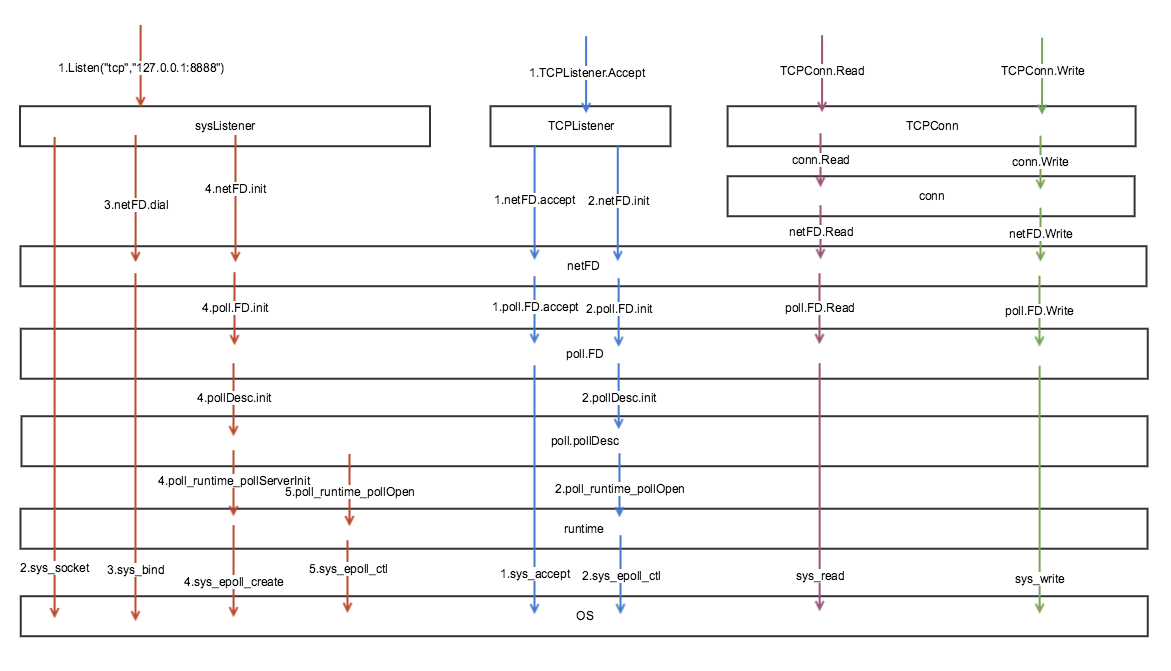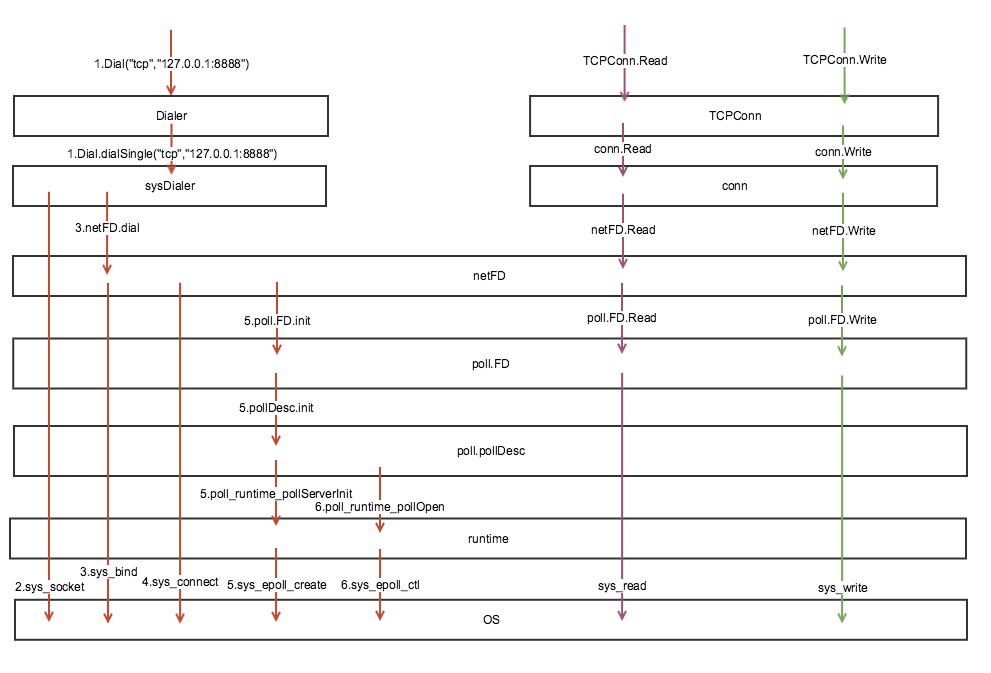本文主要关注以下几个问题:
- Golang runtime 是怎么调用 epoll 的系统调用的 ?
- Golang net 库如何封装 epoll,使得开发者几乎不用直接操作 epoll ?
C 如何调用 epoll
首先回顾一下用 C 语言怎么使用 epoll
int s = socket(AF_INET, SOCK_STREAM, 0);
bind(s...)
listen(s...)
int epfd = epoll_create(128); //创建eventpoll对象
ev.events = _EPOLLIN | _EPOLLOUT | _EPOLLRDHUP | _EPOLLET
epoll_ctl(epfd, EPOLL_CTL_ADD, s, &ev);//注册事件
//轮询就绪事件
while(true){
//返回值n为就绪的事件数,events为事件列表
int n = epoll_wait(epfd, &events[0], len(events), 1000)
for( i := 0; i < n; i++ ) {
ev := &events[i]
//处理事件
}
}
C 语言中调用 epoll 的方式比较底层,总的来说分下面三个步骤
- epoll_create() 创建epoll对象
- epoll_ctl() 注册套接字的事件
- epoll_wait() 轮询是否有事件发生,并通过events参数返回就绪(触发)的事件列表
Go 如何调用 epoll
那么在 Golang 的 runtime 最终也是调用了这么底层的 glibc 库函数吗? Golang 是如何封装 epoll 的呢?
搜索之后在 runtime/sys_linux_amd64.s 文件下面找到了 epollctl()
// func epollctl(epfd, op, fd int32, ev *epollEvent) int
TEXT runtime·epollctl(SB),NOSPLIT,$0
MOVL epfd+0(FP), DI
MOVL op+4(FP), SI
MOVL fd+8(FP), DX
MOVQ ev+16(FP), R10
MOVL $SYS_epoll_ctl, AX
SYSCALL
MOVL AX, ret+24(FP)
RET
可见,Golang runtime 最后是直接用汇编调用 系统调用 epollctl,类似的,在同一个文件下也能找到 epoll create 和 wait 的汇编代码。
知道了这些之后,我们再来看看 Golang 的网络库 net 是怎么封装 epoll 的。
Go 如何封装 epoll
Golang net 库封装 epoll 核心文件在系统文件 src/runtime/netpoll.go, 这个文件对不同平台的 API 进行封装,Linux 平台相关的部分在 src/runtime/netpoll_epoll.go 。
自顶向下,先看看开发者如何调用 Go 封装好的接口的
func main() {
ln, err := net.Listen("tcp", ":8080")
if err != nil {
panic(err)
}
for {
conn, err := ln.Accept()
if err != nil {
panic(err)
}
go handleConnection(conn)
}
}
func handleConnection(conn net.Conn) {
var body [4]byte
addr := conn.RemoteAddr()
for {
conn.Read(body[:])
conn.Write(body[:])
}
}
以上是一个最简单的 Golang TCP server 的例子,由此可见,开发者仅仅需要调用 Listen(), Accept(), Read(), Write() 等函数即可,完全不用管理 epoll
Listen 做了什么
从 Listen 函数开始,整体的调用链如下
- lc.Listen()
- sl.listenTCP()
- internetSocket()
- socket() 调用 sysSocket() 返回一个 int 的文件描述符,newFD() 创建一个 netFD 结构,并且进入 listenStream()
- listenStream() 中调用 fd.init()
func (fd *netFD) init() error {
// pfd mean poll FD
return fd.pfd.Init(fd.net, true)
}
- fd.pfd.Init()
func (fd *FD) Init(net string, pollable bool) error {
// pd means pollDesc
err := fd.pd.init(fd)
return err
}
- fd.pd.init() 中的 pd 是
pollDesc的缩写,在poll/fd_unix.go文件中,有关于 FD 结构体的定义
// FD is a file descriptor. The net and os packages use this type as a
// field of a larger type representing a network connection or OS file.
type FD struct {
// Lock sysfd and serialize access to Read and Write methods.
fdmu fdMutex
// System file descriptor. Immutable until Close.
Sysfd int
// I/O poller.
pd pollDesc
}
可见,每一个文件描述符都对应了一个 IO poller,Golang runtime 就是把这些 poller 连成链表进行管理的,具体的在下面小节再介绍。 我们先看看 pollDesc 的 init 函数做了些什么
func (pd *pollDesc) init(fd *FD) error {
serverInit.Do(runtime_pollServerInit) // init epoll 只需要做一次,每个进程只做一次
ctx, errno := runtime_pollOpen(uintptr(fd.Sysfd))
if errno != 0 {
if ctx != 0 {
runtime_pollUnblock(ctx)
runtime_pollClose(ctx)
}
return errnoErr(syscall.Errno(errno))
}
pd.runtimeCtx = ctx
return nil
}
runtime_pollServerInit() 对应 Golang Runtime 中的 poll_runtime_pollServerInit() 函数。
func poll_runtime_pollServerInit() {
netpollGenericInit()
}
func netpollGenericInit() {
if atomic.Load(&netpollInited) == 0 {
lock(&netpollInitLock)
if netpollInited == 0 {
netpollinit()
atomic.Store(&netpollInited, 1)
}
unlock(&netpollInitLock)
}
}
查看 netpollinit() 的函数,不难发现就是在这里调用了 epollcreate1() 和 epollctl()
同样的,runtime_pollOpen函数对应 Golang 运行时的 poll_runtime_pollOpen() 函数。
func poll_runtime_pollOpen(fd uintptr) (*pollDesc, int) {
pd := pollcache.alloc()
errno = netpollopen(fd, pd)
return pd, int(errno)
}
最后在 netpollopen() 函数中,把这个 fd 注册 epoll 的可读,可写,挂断,边沿触发等事件。
到此,从 socket() 系统调用返回的 fd,到把这个 fd 注册 epoll 事件的过程已经完成,这么长的过程, 其实只完成了开头 C 语言前 8 行的工作,对应 Go 的 server 代码,也仅仅是完成了 Listen 函数
Accept 做了什么
自顶向下,Accept 的主要函数调用链如下
- TCPListener accept()
- netFD 的 accept(),在这里创建一个新的 netFD 并初始化
- FD 的 Accept() 会重置pollDesc中的rg, 并调用原始套接字的accept接口返回一个 fd。等待连接到来,如果返回 EGAIN,则当前g 被gorpark
func (fd *netFD) accept() (netfd *netFD, err error) {
// 获取文件描述符 d
d, rsa, errcall, err := fd.pfd.Accept()
// 创建新 netFD
if netfd, err = newFD(d, fd.family, fd.sotype, fd.net); err != nil {
poll.CloseFunc(d)
return nil, err
}
// 与 Listen 一样的初始化,把 fd 注册到 epoll
if err = netfd.init(); err != nil {
netfd.Close()
return nil, err
}
return netfd, nil
}
上面代码的 fd.pfd.Accept() 具体过程如下
func (fd *FD) Accept() (int, syscall.Sockaddr, string, error) {
if err := fd.readLock(); err != nil {
return -1, nil, "", err
}
defer fd.readUnlock()
// 重置pollDesc中的 rg
if err := fd.pd.prepareRead(fd.isFile); err != nil {
return -1, nil, "", err
}
for {
s, rsa, errcall, err := accept(fd.Sysfd)
if err == nil {
return s, rsa, "", err
}
switch err {
case syscall.EINTR:
continue
case syscall.EAGAIN:
if fd.pd.pollable() {
if err = fd.pd.waitRead(fd.isFile); err == nil {
continue
}
}
case syscall.ECONNABORTED:
// This means that a socket on the listen
// queue was closed before we Accept()ed it;
// it's a silly error, so try again.
continue
}
return -1, nil, errcall, err
}
}
Read/Write 做了什么
调用关系是 conn.Read -> netFD.Read -> FD.Read,其中重点是 FD.Read
func (fd *FD) Read(p []byte) (int, error) {
if err := fd.readLock(); err != nil {
return 0, err
}
defer fd.readUnlock()
if len(p) == 0 {
return 0, nil
}
// 重置 pollDesc.rg 为 0
if err := fd.pd.prepareRead(fd.isFile); err != nil {
return 0, err
}
if fd.IsStream && len(p) > maxRW {
p = p[:maxRW]
}
for {
n, err := ignoringEINTR(func() (int, error) { return syscall.Read(fd.Sysfd, p) })
if err != nil {
n = 0
if err == syscall.EAGAIN && fd.pd.pollable() {
if err = fd.pd.waitRead(fd.isFile); err == nil {
continue
}
}
}
err = fd.eofError(n, err)
return n, err
}
}
从上面的 fd.pd.waitRead() 继续跟踪,发现最后是调用了 poll_runtime_pollWait(),最后在 netpollblock() 中调用 gopark 把当前 goroutine 给 park 住。
由此可以看出,Read 和 Write 函数并不是靠 epoll_wait() 进行阻塞和等待的,而是被 Go Runtime park 住了,所以让开发者感觉像是 Read() 被阻塞了。
实际上,Golang 中所有文件描述符都被设置成非阻塞的,某个 goroutine 进行网络io操作,读或者写文件描述符,如果此刻网络io还没准备好, 则这个 goroutine 会被放到系统的等待队列中,这个 goroutine 失去了运行权,但并不是真正的整个系统“阻塞”于系统调用,后台还有一个poller会不停地进行poll, 所有的文件描述符都被添加到了这个 poller 中的,当某个时刻一个文件描述符准备好了,poller 就会唤醒之前因它而阻塞的 goroutine,于是 goroutine 重新运行起来。
netpoll 轮询 fd
Go runtime 中专门的轮询器实现是在 netpoll_epoll.go 中的 netpoll() 函数,这里才是真正调用 epollwait() 的地方。
除了 netpoll 函数以外,还有其他几个辅助函数:
- runtime.netpollinit(), 初始化网络轮询器,通过 sync.Once 和 netpollInited 变量保证函数只会调用一次
- runtime.netpollopen(), 监听文件描述符上的边缘触发事件,创建事件并加入监听;
- runtime.netpoll(), 轮询网络并返回一组已经准备就绪的 Goroutine
- runtime.netpollBreak(), 唤醒网络轮询器
而调用 netpoll() 函数的则是 Go runtime 中的 findrunnable() 和 sysmon()
pollDesc
上面提到,Golang 中所有的文件描述符都是非阻塞的,具体到网络 socket 的文件描述符, Golang 的网络操作都以 netFD 为中心实现。
netFD 与底层 PollDesc 结构绑定,当在一个 netFD 上读写遇到 EAGAIN 错误时, 就将当前 goroutine 存储到这个 netFD 对应的 PollDesc 中,同时调用 gopark 把当前 goroutine 给 park 住,直到这个 netFD 上再次发生读写事件, 才将此 goroutine 重新运行。
Golang Runtime 中有一个 runtime.pollCache 的全局变量,通过每个FD 中的 pollDesc, 把所有 FD 连成了一个链表,Go 语言网络轮询器会监听 runtime.pollDesc 结构体的状态。
总结
以上就是 Go 对 epoll 的封装,使得程序员在调用 Listen(), Accept() 的时候,完全不用对 epoll 的细节进行管理,提高了开发者的效率。
其中 gopark 和 pollDesc 的部分牵涉到 Go runtime 的设计与实现,在本文中没有详细展开。
最后用两张网上的截图回顾一下 server 端和 client 端函数调用链:
TCP Server

TCP Client
